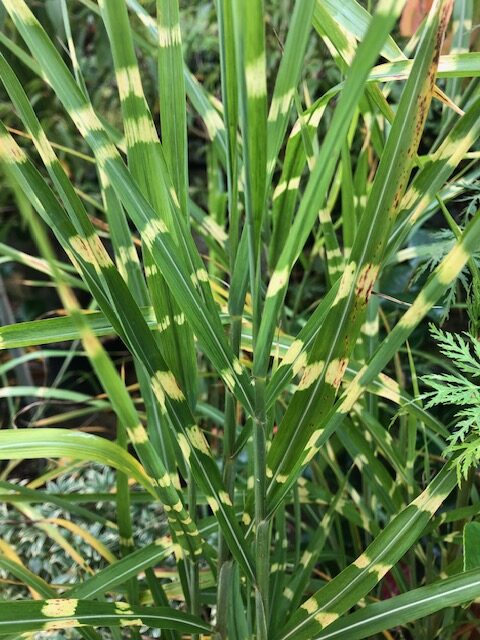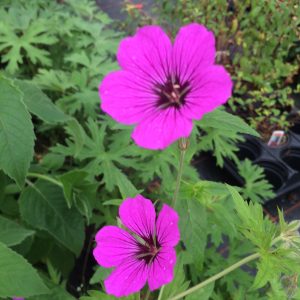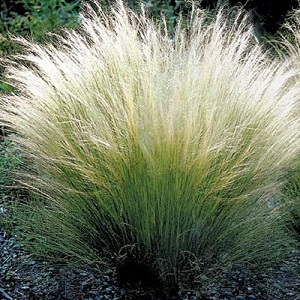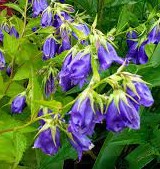Miscanthus Sinensis Zebrinus
Zebra grass
Miscanthus sinensis ‘Zebrinus’ is renowned for its distinctive, arching leaves that can reach up to 6–8 feet in height, with a spread of around 4–6 feet. The foliage of the plant is its most defining feature, the long, narrow leaves are medium to dark green, adorned with the characteristic zebra-like stripes that run horizontally across the leaf blades, and silky, finger-like flowerspikes can appear in late summer. If these do appear, they are usually retained for several months, so give this plant a dramatic winter presence. Use it as a specimen, or as a backdrop to late flowering border perennials.
Miscanthus sinensis ‘Zebrinus’, commonly referred to as zebra grass, is a striking ornamental plant that belongs to the Poaceae family (the grass family). It is a cultivar of the species Miscanthus sinensis, which originates from East Asia, particularly China, Japan, and Korea. Known for its bold appearance, this perennial grass is celebrated in gardens for its unique variegated foliage, which features irregular yellow or cream-colored horizontal bands resembling the stripes of a zebra, hence its common name.
As the growing season progresses, in late summer to early autumn, Miscanthus sinensis ‘Zebrinus’ produces delicate, pinkish-silver flower plumes that rise above the foliage. These feathery panicles can reach up to 12 inches in length and add a soft, airy texture to the plant. Over time, the flowers mature and take on a silvery-white hue, persisting through winter and providing interest during the colder months. The combination of foliage and flowers makes zebra grass a year-round attraction in gardens.
Zebra grass is a hardy, low-maintenance plant that thrives in a variety of conditions. It is hardy in the UK making it a versatile choice for many regions. The plant prefers full sun but can tolerate light shade, though its characteristic variegation is more pronounced in sunnier locations. Well-drained soil is ideal for Miscanthus sinensis ‘Zebrinus’, but it is also adaptable to different soil types, from sandy to clay-rich soils, as long as the drainage is adequate.
One of the key strengths of zebra grass is its drought tolerance. Once established, it can withstand periods of low water availability, making it a suitable option for xeriscaping or low-water gardens. However, for optimal growth and vibrant foliage, regular watering during dry spells is beneficial.
Miscanthus sinensis ‘Zebrinus’ requires minimal care, making it a popular choice for gardeners seeking a low-maintenance yet visually impactful plant. The main task in caring for zebra grass is cutting back the old growth in late winter or early spring, just before new shoots emerge. This annual pruning helps to maintain the plant’s shape and encourages healthy growth in the upcoming season.
In terms of feeding, zebra grass is not particularly fussy, but an application of a balanced fertilizer in spring can help promote vigorous growth. Due to its size, zebra grass can become dense over time, and division every three to four years is recommended to prevent overcrowding and to rejuvenate the plant.
Pest and disease problems are rare in Miscanthus sinensis ‘Zebrinus’. Occasionally, the plant may attract aphids or other small insects, but these issues are typically minor and can be controlled with insecticidal soap or by encouraging natural predators.
Miscanthus sinensis ‘Zebrinus’ is highly valued in garden design for its structural presence and bold foliage. It works well as a focal point in garden beds or borders, where its height and striking variegation draw attention. Zebra grass is also commonly used in mass plantings to create natural screens or hedges, providing privacy while adding an ornamental touch.
The plant’s vertical lines and airy texture contrast beautifully with lower-growing perennials and groundcovers. It pairs well with other grasses, flowering plants, or shrubs that have a more compact or rounded form. Additionally, its flower plumes add a dynamic, graceful element to the garden in late summer and Autumn, catching the light and swaying gently in the wind. Moreover, the dried flower heads of Miscanthus sinensis ‘Zebrinus’ are often used in floral arrangements, adding an elegant and textural component to both fresh and dried bouquets. In winter, the plant’s dried stems and plumes provide a structural element to the garden, offering interest when many other plants have faded.
In addition to its aesthetic value, zebra grass offers several environmental benefits. It provides habitat and shelter for wildlife, particularly birds, which may use the plant for cover or nest-building materials. The dense clumps of the grass can also help prevent soil erosion, especially on slopes or areas prone to runoff. Miscanthus species, including ‘Zebrinus’, are also recognized for their potential as bioenergy crops due to their fast growth and high biomass production.
Miscanthus sinensis ‘Zebrinus’ is a versatile and visually striking addition to any garden. With its bold, striped foliage, towering height, and feathery flower plumes, it brings texture, color, and year-round interest to landscapes. Its adaptability to different growing conditions, low maintenance needs, and environmental benefits make it a popular choice for both novice and experienced gardeners looking to add a dramatic focal point to their outdoor space.






Reviews
There are no reviews yet.